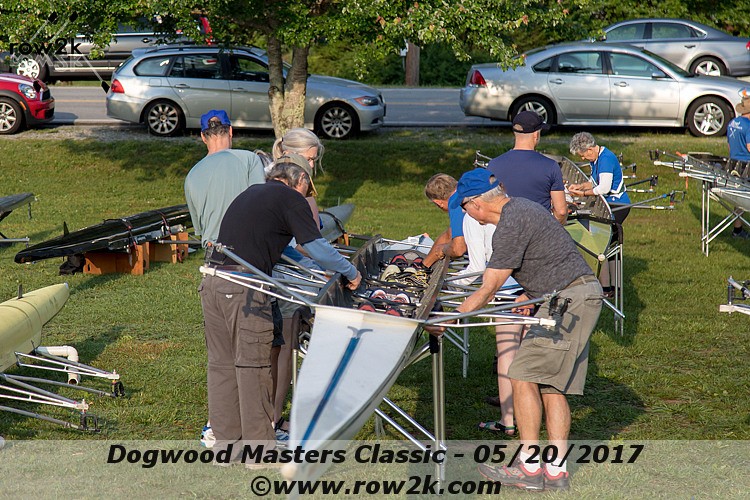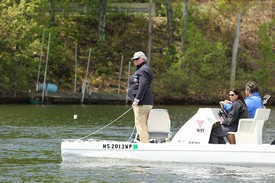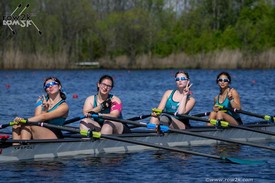Adapting rowing/rigging for masters physiology

Masters rowers fundamentally are no different from any other age group. However, regular competitors know that your strength and flexibility changes as you age and so it is helpful to re-assess rigging and boat set up regularly for masters training groups.
Comfort in the Boat
The goal of rowing and sculling boat rigging for masters is twofold:
- Be able to move through the stroke cycle
- Be comfortable while doing it
Let's start by reviewing the parts of a rowing boat which are capable of adjustment and the degree of difficulty involved in changing each.
| Oar length | easy to change |
| Oar inboard | easy to change |
| Oar handle size | moderately difficult to change |
| Seat height | easy to change |
| Slide / track position | moderately difficult to change |
| Foot Stretcher position | easy to change |
| Shoe height | moderately difficult to change |
| Foot stretcher angle / rake | hard to change |
| Rigger pin position (span / spread) | hard to change |
| Rigger pin pitch (fore/aft and lateral) | hard to change |
| Oarlock height | easy to change |
My assessment of easy/moderate/hard is based on the amount of time, tools and skill needed to make a change. For example, a club who uses snap-lock washers on the oarlocks will find it very easy to change the oarlock heights on the water. Changing your slide position on the water is more challenging - but easy to do off the water with the boat on trestles. Adjusting the rigger pin takes tools, time and expertise and so is classified as hard.
Knowing what can be changed is a good starting point. Any change has to be made with reference to an "ideal" or preferred situation. Therefore rowing groups should all know some basic principles of rigging which can be adapted for taller or shorter people.
Key Rowing Rig Positions for athletes
1. Oar handle relative to the body at the finish (sweep and sculling)
2. Shoe height relative to seat height
3. Sill of oarlock relative to the water
There are some fixed positions that rowers should be able to achieve:
- Full compression at the catch, shins vertical, hips square off from the pin, oar spoons buried under the water
- At the sculling finish blades buried under the water, wrist and forearms flat, elbows at 90 degrees to the oar shaft, thumbs brushing your lower ribs
- At the sweep finish blades buried under the water, outside hand thumb brushes lower ribs
- Mid-recovery oar spoons capable of square blades above the water surface
These give you clear points in the rowing stroke cycle to check against what your athletes actually do when they are rowing. Note that many will be able to get into these positions when the boat is stationary, check if they actually do it while rowing continuously.
Easy rigging fixes for you to try
Problem: not enough space between the handles at the sculling finish - Move foot stretcher towards bow
- Shorten inboard on oars [keep outboard the same if the athlete is a novice]
Problem: Handles can go past the body at the sculling finish
- Move foot stretcher towards stern
Problem: Cannot get shins vertical at the catch
- Lower shoes on foot stretcher and / or
- Use a seat pad to raise seat height
Problem: Cannot get back rocked forward with shoulders in front of hips on recovery
- Lower shoes on foot stretcher and / or
- Use a seat pad to raise seat height - or two seat pads
Problem: Cannot keep oars buried at the finish under the water
- Lower oarlock height
- Use a seat pad to raise seat height
Problem: Tall athlete rowing with a shorter athlete
- Set oarlocks high / low for the tall / short athlete
- Shorten oar length and inboard for short athlete (keep outboard ratio the same)
Problem: Big shoes in the boat and athletes with smaller feet
- Wear neoprene beach shoes inside the boat shoes
- Raise the shoes as high as possible on the foot stretcher so the heels are elevated
Most rigging fixes are a combination of recognizing a problem and knowing what to try as a possible solution. As a rule, only make one change at a time, go rowing and see what the change is before making another change.

Marlene Royle and Rebecca Caroe coach at Faster Masters Rowing Programs, video & technique for masters .
If you enjoy and rely on row2k, we need your help to be able to keep doing all this. Though row2k sometimes looks like a big, outside-funded operation, it mainly runs on enthusiasm and grit. Help us keep it coming, thank you! Learn more.
Comments | Log in to comment |
There are no Comments yet
| |
- Bont Rowing
- Calm Waters Rowing
- Concept 2
- Craftsbury Sculling
- The Crew Classic
- CrewLAB
- Croker
- Dad Vail Regatta
- Durham Boat Co.
- Empacher
- Faster Masters
- Filippi
- Fluidesign
- h2row.net
- HUDSON
- Live2Row Studios
- Nielsen-Kellerman
- Oak Ridge RA
- Peinert Boat Works
- Pocock Racing Shells
- Race1 USA
- Rockland Rowing Masters Regatta
- RowKraft
- Rubini Jewelers
- Vespoli USA
- WinTech Racing
- Bont Rowing
- Calm Waters Rowing
- Concept 2
- Craftsbury Sculling
- The Crew Classic
- CrewLAB
- Croker
- Dad Vail Regatta
- Durham Boat Co.
- Empacher
- Faster Masters
- Filippi
- Fluidesign
- h2row.net
- HUDSON
- Live2Row Studios
- Nielsen-Kellerman
- Oak Ridge RA
- Peinert Boat Works
- Pocock Racing Shells
- Race1 USA
- Rockland Rowing Masters Regatta
- RowKraft
- Rubini Jewelers
- Vespoli USA
- WinTech Racing

















